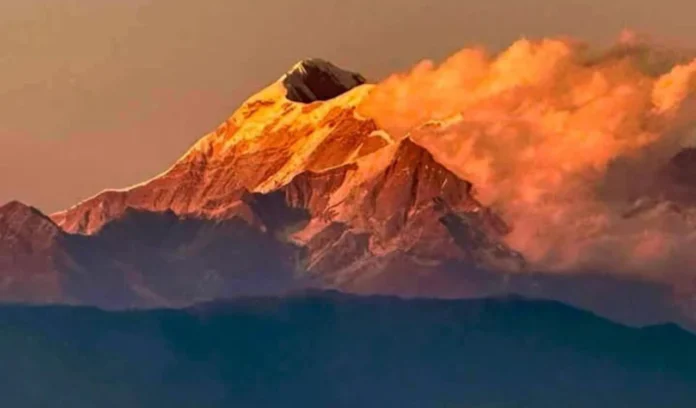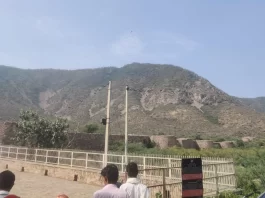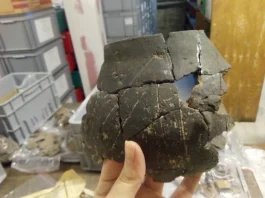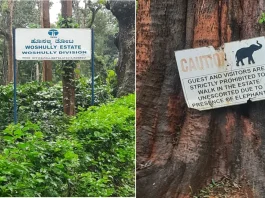The beauty of the Himalayas from Himachal to Arunachal is a breathtaking spectacle of towering, mist-shrouded peaks, deep valleys, and lush forests, where the landscape transitions from the pine-scented air and sparkling rivers of the west to the rugged, subtropical-to-alpine terrains of the east. The journey offers diverse experiences, from the clear, sunlit rivers and scattered snow in Himachal to the dramatic, misty hills and waterfalls of Arunachal Pradesh, a region often called the ‘Land of the Rising Sun.’ The sheer scale, dramatic landscapes, and serene atmosphere provide a magical, picturesque experience throughout this eastern section of the mighty mountain range.
While the entire beautiful misty Himalayas abound in the serene, mist-laden peaks and valleys, to me ‘The Kumaon Hills’ are where deafening silence and quiet solitude are broken only by the sounds of nature, and every vista is a breathtaking panorama. Visitors can find tranquility in this region, which offers fresh mountain air, vibrant forests, and a sense of peace that can be overwhelming, where I meet my gods as time slows down and nature’s space expands with the musical sound of a cool breeze whistling through trees, beautiful Kumaoni bhullis carrying forest wood for kitchen fuel, grass for domestic milking and ploughing animals, wild animals in forests, the yield of farming fields for survival, grazing cows along the roads and undulating fields, the chirping of hosts of birds, and creepers both visible and invisible to the eyes but soothing to the body, mind, and soul. This is enhanced by the stunning visual spectacle of sunrises painting the snow-capped mountains and the dynamic, ever-changing play of clouds and sunlight constantly reshaping the natural scenery.
Simple rock-mud plastered hutments with red or green slanting tin sheets absorbing sun rays and heat for natural warmth and air conditioning; tea, sweets, and noodle stalls that are fast replacing pakoras and samosas along the fewer serpentine roads; high sculpted power line towers with sagging high-tension power lines tranquilising the horizon; vast forests of pine, oak, and occasional rhododendron trees known for their large, colorful red flowers used in making natural rejuvenating rhododendron syrup. Bedu is a wild berry that grows abundantly in the hilly terrains, particularly in the Garhwal and Kumaon regions. The small Bedu berries’ round fruits start green and gradually ripen to a luscious red or orange, and the tall Kafal trees with small red wild berries are popular for their sweet-tangy flavour and immense cultural significance in Uttarakhand, forming the region’s rich biodiversity, lush green landscape, vibrant flora, and natural beauty. Both bedu and kafal wild berries led Mohan Upreti to compose the soul-stirring folk song ‘Bedu Pako Baro Masa, Kafal Pako Chaita’ in the early 1950s, and it has since become popular all over Uttarakhand as a traditional folk song, a sort of Kumaoni anthem in the villages in the Kumaon region. It was one of the favourite songs of Mr Nehru, the first Prime Minister of India who chose it as the best folk song from India, thus instantly making Mohan Upreti popular as the Bedu Pako Boy. This song is the official regimental song of the Kumaon Regiment and enjoyed equally by the Garhwali troops and the Indian Army.
The Kumaoni folk song ‘Chena Billori, Jandiya Bajo’ is a poignant narrative capturing the anxieties of a young Kumaoni bride pleading with her father (Bajo) not to marry her into the distant village of Chana Billori, which is symbolically depicted as a harsh place with intense sun (lagni ghama), representing the collective struggles and hardships faced by women in the mountains who had to leave their familial homes and adapt to challenging new lives after marriage. The song remains a powerful and relatable piece of Kumaoni culture, reflecting the enduring essence of mountain life struggles.
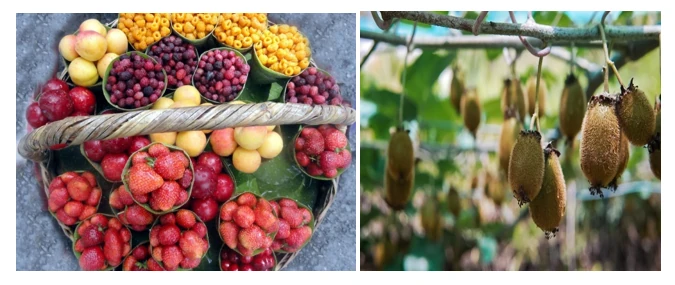
The Kumaon Hills are known for their diverse range of fruits, which are not only a source of livelihood for local farmers but also a significant part of the region’s culture and economy. The Kumaon Hills region, often referred to as the ‘Fruit Bowl of Kumaon,’ is known for a diverse range of temperate and local wild fruits. Delicious strawberries known for their high quality and organic chemical-free fertilizers are cultivated in Almora, Bageshwar, Bhimtal, Bhowali, Jeolikot, Kausani, Mukteshwar, Nainital, Ramgarh, and Ranikhet, which are also popular hill stations and ideal heavenly places to spend the summer holidays in a calm, secluded, and cool environment for nature lovers and those visitors interested in butterflywatching, floriculture, and idling in star-lit wintry nights with natural earthly comforts as stress busters. Mountaineering, trekking, golf, paragliding, yachting in lakes, and mountain cycling are enjoyable sports in the region.
Sweet and tangy plums are grown all over elevated hills and enjoyed as juice, chutney, and jam. Hisalu, full of energy; Kafal in Chaitya (March-April); Bedu round the year (Barrah Massa); and apple orchards grow fruits all over the Kumaon hills.
The landscape contributes to the local natural beauty and supports the economy through agriculture, horticulture, and tourism-based cottage industries, playing a significant role in the region’s agricultural prowess, culture, and social lifestyle. People from the plains and other parts of the country have traveled through enchanting Kumaoni hill stations for ages for their pristine natural beauty, and the fruits add sweetness, vitamins, and minerals much needed for their health.
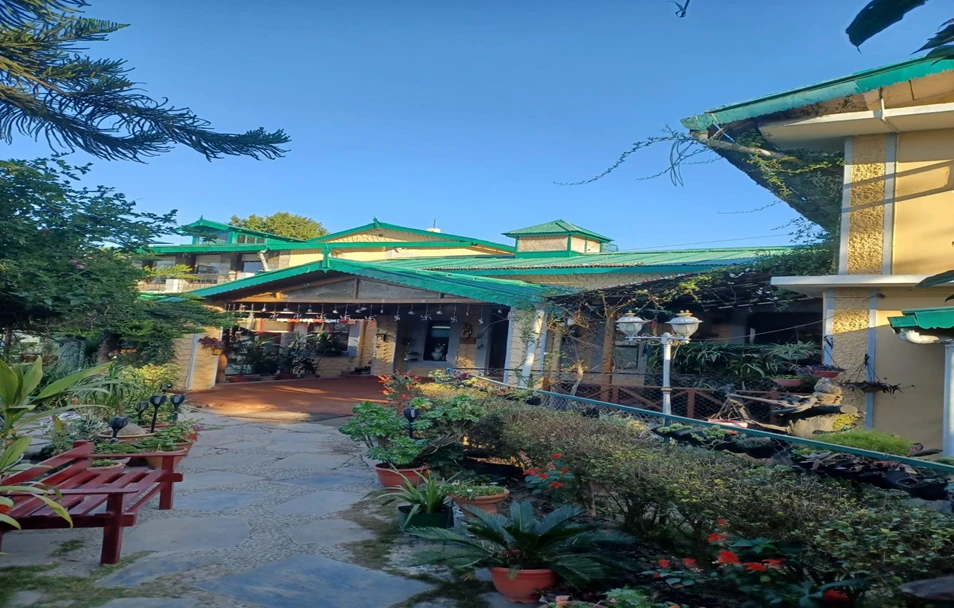
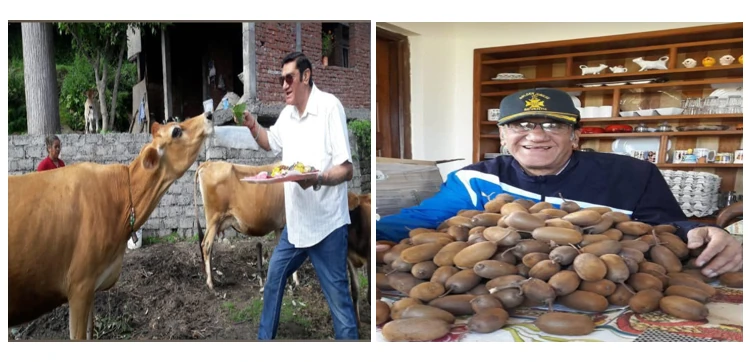
It is always my immense pleasure to visit Lt. Gen. Mohan Bhandari’s palatial and spacious cottage atop a hill with majestic views of so many snow-clad Himalayan peaks, like Trishul, Nanda Devi, Nandkot, and many more named after local deities worshipped. His well-manicured garden, apples, plums, kiwi trees, clean milking cows’ sheds, and hospitality are well known in the region! His late grandfather, Rai Sahib BD Bhandari, and father, Shri MD Bhandari, were renowned lawyers in Ranikhet and fought legal cases of Britishers before independence and the Regimental Centre and Cantonment Board thereafter. This cottage, known as Herbert House, was constructed in 1916 by Mr. Herbert, then Cantonment Magistrate – a BIG Gora Sahib those days, and a good friend of his grandfather, who acquired it. This heritage cottage was renovated by his grandfather and father, whom I knew very well personally, and Gen Bhandari frequently. Both Gen & Mrs. Bhandari live in this cottage, rightly renamed as General’s Retreat, in the company of their 3 cows—Taara, Lakshmi, and Gauri—and 3 black dogs, Cheeku, Bella, and Fenny—carriers of Lord Bhairab to protect them! With kids well settled, the couple, with a fleet of dedicated caretakers to look after them, spend their retired life and helping ex-servicemen, Veer Naris, widows, and poor local children in their character and career building.
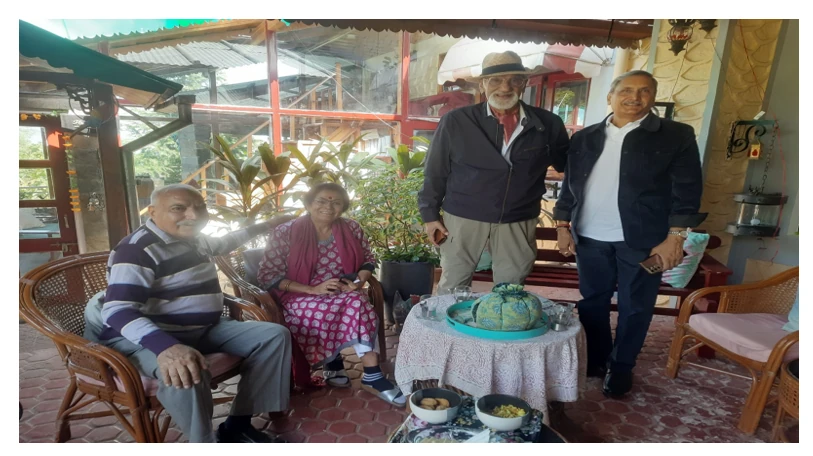
Kumaon Division, known as ‘Abode of Gods,’ is interspersed with endless ancient temples and pilgrimages where every village has a temple or two, beautifully blending in picturesque landscape, culture, religion, spirituality, and history of the area. The Naina Devi Temple in Nainital, a popular tourist destination, honors Goddess Naina Devi, regarded as one of the 51 Shakti Peethas. The eyes of Goddess Sati are said to have fallen, and devotees flock here to seek blessings and experience a sense of tranquility in the divine presence.
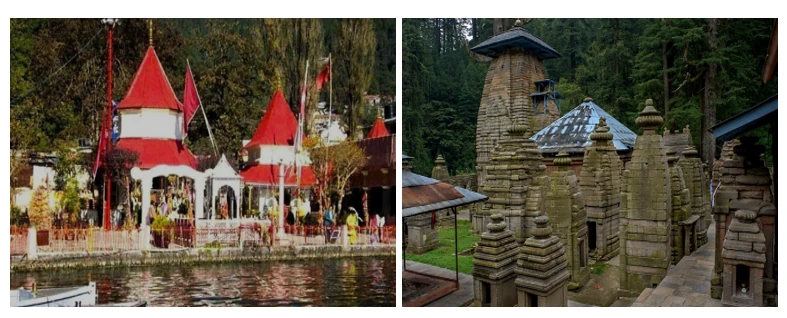
Deep within the serene, dense Deodar forests in Almora lies Jageshwar Dham, a complex of over 100 ancient temples from the 9th to 13th centuries dedicated to Lord Shiva, which attracts many pilgrims annually during the Jageshwar Monsoon Festival from far and wide, adding a festive aura to this sacred site. There is a mystic temple called Kasar Devi atop a hill of the same name, where it is believed that Swami Vivekananda meditated and experienced profound spiritual revelations.
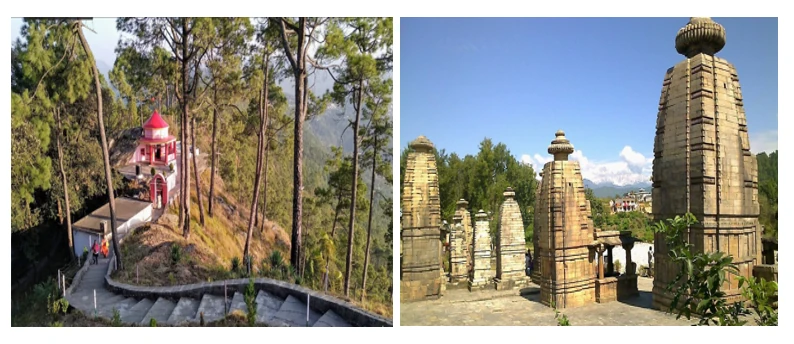
Located in Bageshwar, the Baijnath Temple is an ancient 12th-century shrine dedicated to Lord Shiva as a nostalgic testimony to the architectural brilliance, creating an aura of divinity of the bygone era and drawing large numbers of devotees during the annual Baijnath Mela.
There are temples like the mysterious Lord Shiva’s cave temple, Patal Bhuvaneshwar, hidden within the depths of the Kumaon hills, believed to be the abode of 33 crore deities, intricately carved on the cave walls, offering an awe-inspiring experience to devotees, and the ancient Katarmal Sun Temple in Almora, dedicated to the Sun God, signifying the celestial connection between the sun and life on Earth, offering spiritual solace to pilgrims. Then there is Chitai Golu Devta Temple, adorned with thousands of brass bells signifying blessings and the fulfillment of the prayed-for wishes of the devotees. Gangnath Temple, located in Pithoragarh, is considered the abode of Lord Shiva and Ganga. Ranikhet has the famous Mankameshwar Regimental Mandir beside the Jhoola Devi and Kalika Mandirs, both frequented by tigers and leopards at night. Mukteshwar, at 7500 feet altitude with well-laid cottages and the coolest freezing breeze, provides a breathtaking view of the Himalayan snowcapped peaks and has the Mukteshwar Dham ancient Shiva Temple with a breathless climb. Here is the premier Indian Veterinary Research Institute (IVRI). In fact, every village and small town in the hills has unique Mandirs. Ranikhet and Nainital have many colonial churches and vintage cottages.
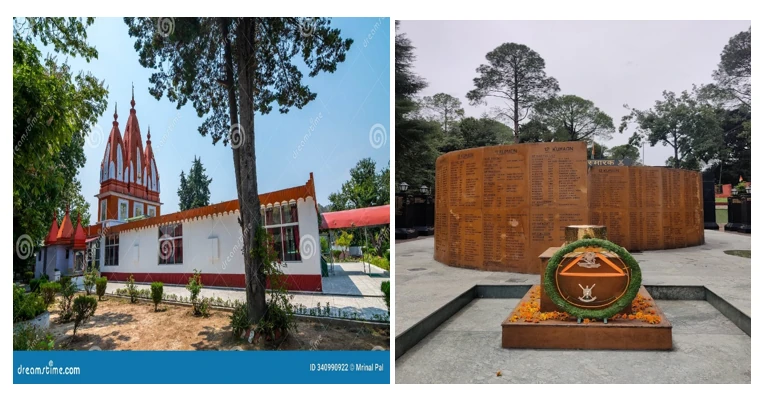
Kainchi Dham is a revered ashram and Hanuman Temple in the Kumaon Hills on the main road leading from Kathgodam to Ranikhet, renowned as a spiritual sanctuary that has attracted global icons seeking peace and tranquility. In the 1970s, Apple co-founder Steve Jobs visited the Ashram, and this journey profoundly influenced his philosophy of simplicity and focus, which became central to Apple’s design. Following the advice he received during a challenging time for his company, Facebook founder Mark Zuckerberg visited the Dham, where he found inspiration and a renewed sense of mission. More recently, Indian cricket superstar Virat Kohli and his wife, actress Anushka Sharma, have visited the ashram to seek blessings and connect with the spiritual energy associated with Neem Karoli Baba. The Baba attained Nirvana in 1973. Every time I, my wife, and my children pass through Kainchi Dham, we pay our obeisance at the temple and enjoy hot tea and pakoras at the adjacent tea stalls.

Nainital, once preferred by the British as the capital over Shimla, has the best of the convent schools and colleges. It is also called ‘The Lake District’ of India. There are four freshwater great lakes in the Kumaon Hills—Nainital Lake, Bhimtal Lake, Naukuchiatal Lake, and Sat Tal Lake. Sat Tal Lake is actually not one lake but a series of seven connected lakes, namely Ram Lake, Sita Lake, Lakshman Lake, Bharat Lake, Garud Lake, Hanuman Lake, and Nal Damyanti Lake.
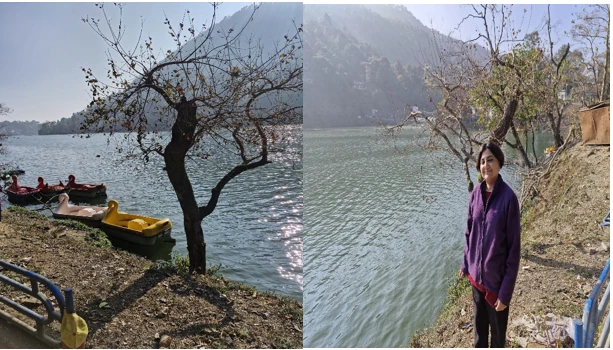

The Kumaon Region is strategically important due to its international borders, and the Indian armed forces maintain a presence in these areas to ensure security and manage border operations and logistics. The region provides warriors for the armed forces and has many cantonments and big and small military garrisons located right in Haldawni, Kathgodam, Nainital, Bhowali, Ranikhet, Chaupattia, Almora, Tanakpur, Pithoragarh, and Dharchula. The main military presence in the region is located at Ranikhet cantonment, which serves as the regimental center for the Kumaon and Naga regiments. Pithoragarh and Dharchula have notable military presences due to their proximity to the Indo-China and Nepal borders. The Indian Air Force (IAF) plans to take control of the strategic airstrip in Pithoragarh for operational and logistical purposes. Tanakpur and Haldawni/Kathgodam also serve as strategic locations and logistical bases for the armed forces in the region. An Inner Line Permit is needed to visit Dharchula.
In the Kumaon Hills, the Jim Corbett Jeep Safari is the most enjoyable wildlife adventure in the national park located along Ramnagar-Ranikhet Road, which is poorly maintained once the park is passed over. Travelers can see the wild animals in their natural habitat, like the Royal Bengal tiger, leopard, elephant, many types of deer (spotted, Sāmbhar, and barking), fox & jackals, wild and sloth bears, Indian grey mongoose, otters, yellow-throated martens, different types of birds, and the Indian python, king cobra, common cobra, and so on. The Binsar Wildlife Bird Sanctuary is located 33 km north of Almora, covering an area of about 47 square km. The sanctuary is known for its rich biodiversity, birds, reptiles, and stunning views of the Himalayan peaks. Both places abound with hotels and lodges for tourists of every budget.

A word about Baal Mithai, the most iconic dessert only available in the Kumaon Hills. It is a blend of roasted khoya, jaggery, and childhood memories that continues to influence and linger in my family’s taste. Though I retired from the Army in 1995, our daughter Neerja and son Gaurav, wherever they served, looked for the Baal Mithai from anyone coming from the KUMAON Hills! Nothing thrills them more than a big bite of ubiquitous Baal Mithai. Incidentally, for many known and unknown reasons, over a century back, Joga Shah in Almora was the only one who made the best Baal Mithai with the famous creamy milk brought from the village of Phalsima near Almora. He was a genius who invented sausage-shaped dark brown mithai wrapped in sugar-dipped khas khas seeds. Later, commercialization and competition led to reduced prices, and sweet shops began using sugary homeopathic pills as ingredients. After Joga, the Routela brothers—Khem Singh and Mohan Singh—made a fortune selling Baal Mithai. The story goes that Joga Shah was actually a Christian named Joga Masih, who became Hindu after the invention and popularity of the Baal Mithai and made a fortune selling it after retiring as a cook from the British Indian Army.
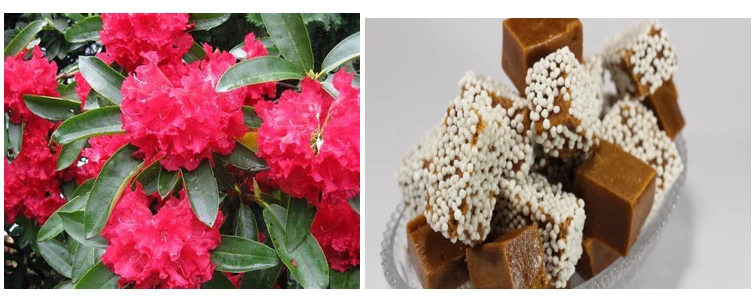
The region is fast becoming a global capital of spirituality, yoga and wellness, local folk fairs, horticulture, handicrafts, hospitality, organic products, wedding destinations, and year-round tourism—all providing employment opportunities to the locals. Sadly, all-round development has brought its own pitfalls. The fragile ecosystem is rapidly deteriorating due to several factors: the influx of a large number of tourists, the construction of big multi-story buildings and massive roads in high seismic zones, poverty, the felling of jungles in collusion with greedy local politicians and contractors, and the survival struggle between humans and wild animals whose natural habitat is declining because of human greed. Kumaon Hills, once the cleanest, are sadly littered by the heavy influx of tourists from the plains throwing plastic waste and empty liquor bottles all along the roads and populated areas. Furthermore, with population explosion and large-scale construction activities, there is an acute shortage of tap water, contrary to governmental claims, and entire hill roads are mushrooming with posh hotels and guest houses for the public at large. Provision of health, education, and jobs; the development of forest- and fruit-based cottage industries; and putting an end to unabated deforestation and the construction industry can only bring solace to these hills presently under avoidable man-made disasters.
